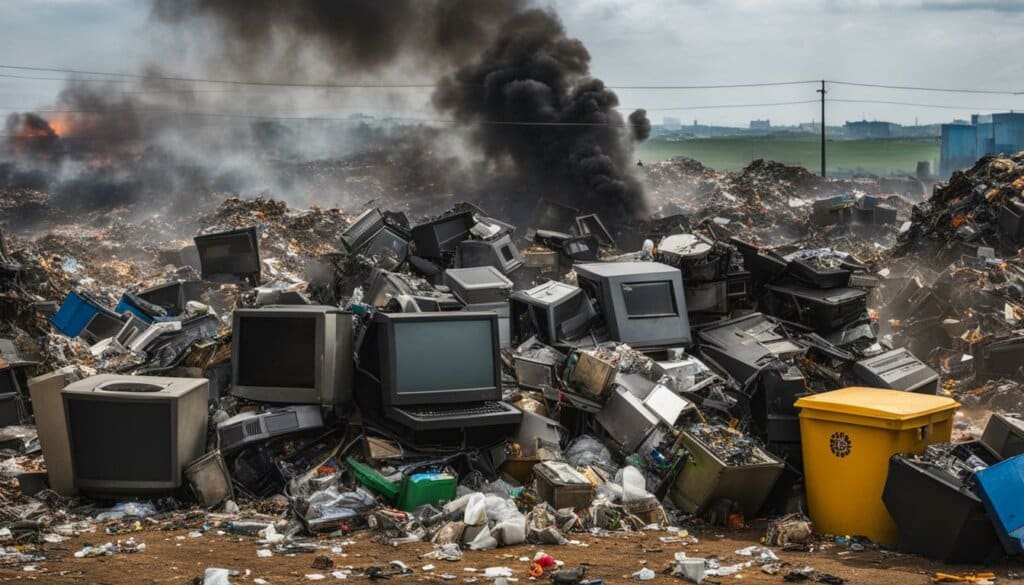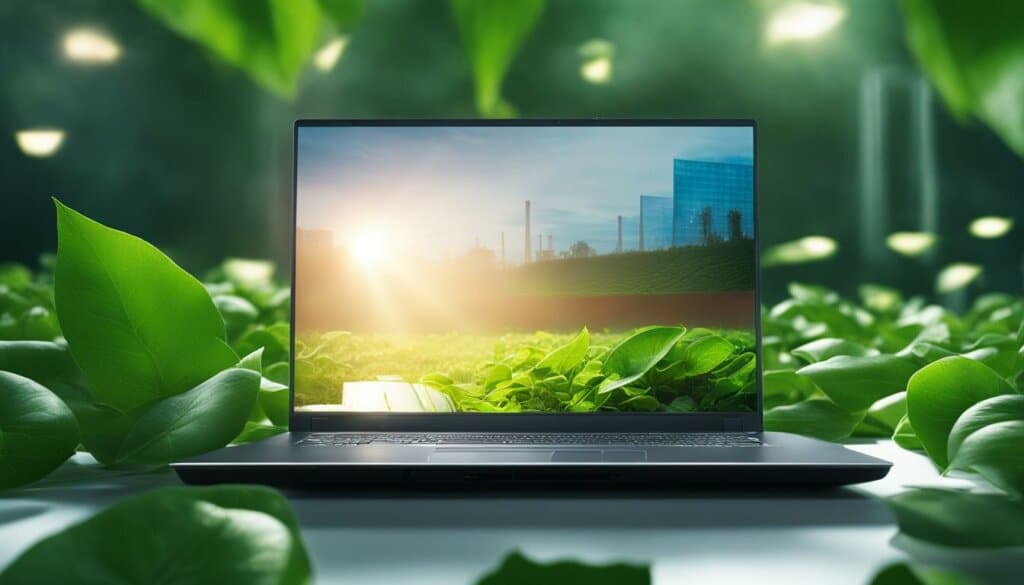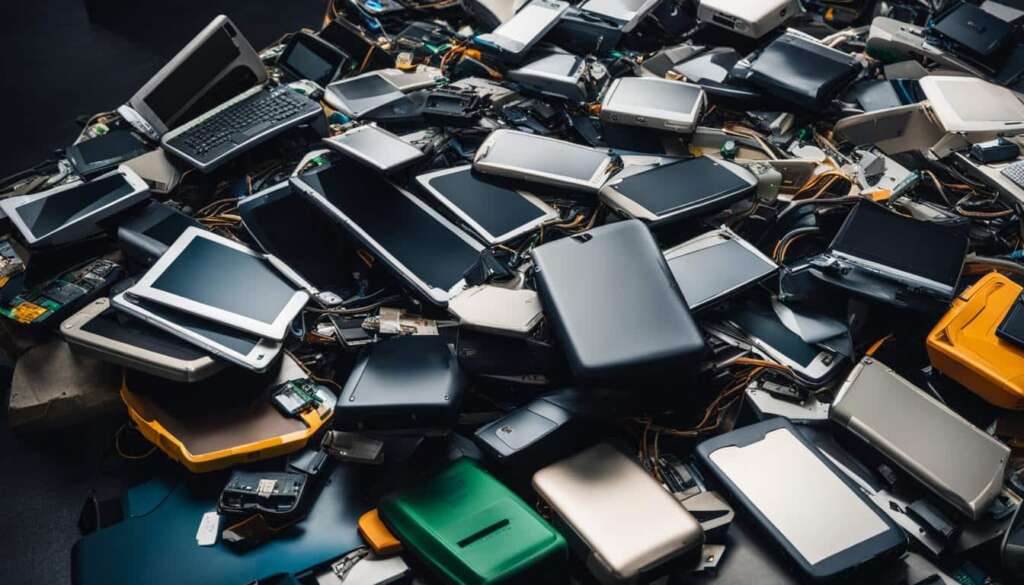Table of Contents
Welcome to our article on the challenge of e-waste and how to responsibly recycle old computers. In today’s world, electronic waste, or Electronic Waste, is a pressing issue that requires immediate attention. From computers to mobile phones, the constant stream of discarded electronic devices poses a significant threat to our environment, human health, and economy.
E-waste, also known as electronic waste, consists of discarded electronic devices that range from computers and televisions to speakers and keyboards. The United States and China are the leading contributors to e-waste production, highlighting the global scale of this problem. Properly managing e-waste is crucial to prevent the release of hazardous materials and promote sustainable waste management practices.
Recycling technology holds the key to responsible e-waste disposal. By recycling old computers and other electronic devices, we can reduce the amount of Electronic Waste that ends up in landfills and mitigate the environmental impact caused by these hazardous materials. In this article, we will explore the growing problem of e-waste, delve into the environmental impact it poses, and discuss the challenges and importance of responsible e-waste disposal.
The Growing Problem of E-Waste
E-waste production is a rapidly growing issue that poses significant challenges for our environment. With the constant introduction of new electronic devices and the shortened lifespan of these products, the amount of e-waste generated is increasing at an alarming rate. Currently, only about 20% of e-waste is recycled, leaving the majority of it to be improperly discarded. It is estimated that by 2030, the e-waste industry will reach nearly 75 million tons annually, more than double the current amount. This exponential growth is driven by our consumeristic society, where products are frequently replaced rather than repaired, leading to a massive accumulation of discarded electronics.
The impact of this growing e-waste crisis is staggering. Improper disposal of e-waste can contaminate habitats, leach toxic chemicals into the soil and water sources, and contribute to air pollution. E-waste contains hazardous materials such as lead, mercury, cadmium, and beryllium, which can have serious health implications for both humans and wildlife. These toxic substances can seep into the environment, posing a risk to ecosystems and further exacerbating the global pollution problem. It is crucial that we address this issue and find sustainable solutions to manage e-waste effectively.
The Environmental Impact of E-Waste
E-waste, or electronic waste, poses a significant environmental threat due to the presence of toxic materials that can contaminate the air, soil, and water. The improper disposal of Electronic Waste in landfills can lead to the seepage of harmful chemicals, such as lead, mercury, cadmium, and beryllium, into the surrounding environment.
When e-waste is subjected to extreme heat, it releases air pollutants that contribute to air pollution, posing a risk to human health and the environment. These pollutants can have detrimental effects on air quality and contribute to respiratory problems.
“E-waste contains a range of hazardous substances that can have serious environmental impacts,” says Dr. Jane Smith, an environmental scientist. “It’s crucial that we properly manage and dispose of e-waste to protect our ecosystems and minimize the release of harmful toxins.”
In addition to air pollution, e-waste contamination can also affect water sources. When toxic substances from e-waste seep into the soil, they can contaminate groundwater and nearby bodies of water, posing risks to aquatic life and human consumption.
| Environmental Impact | Description |
|---|---|
| Electronic Waste Pollution | Electronic Waste releases toxic chemicals into the environment, contributing to pollution and contaminating ecosystems. |
| Electronic Waste Contamination | The presence of hazardous materials in Electronic Waste can contaminate soil, water, and wildlife, posing risks to human health and the environment. |
| Toxins in Electronic Waste | E-waste contains toxic substances such as lead, mercury, cadmium, and beryllium, which can have harmful effects on human health and the environment when improperly handled or disposed of. |
| Air Pollution from Electronic Waste | When Electronic Waste is exposed to extreme heat, it releases air pollutants, contributing to air pollution and affecting air quality. |
| Water Contamination from E-Waste | Improper disposal of Electronic Waste can lead to the contamination of water sources, endangering aquatic life and human consumption. |
The Challenges of Electronic Waste Recycling
E-waste recycling poses various challenges due to the complexity of electronic devices and the need for material separation and sorting. The recycling process involves dismantling electronics, crushing them into smaller sizes, and separating fine materials such as glass, plastics, and metals. This intricate process is labor-intensive and resource-intensive, requiring efficient screening and sorting solutions to handle large volumes of e-waste and improve recycling efficiency.
The complexity of electronic devices is one of the primary challenges in e-waste recycling. Electronics are composed of multiple materials, each requiring specific separation methods. For example, precious metals like gold and silver are often found in circuit boards and connectors, while plastics and glass need to be separated for proper recycling. The lack of standardized design and materials in electronic products further complicates the recycling process, as different devices require different handling methods.
Material separation is a crucial step in Electronic Waste recycling. Specialized machinery and techniques are needed to identify and separate different materials with minimum contamination. For instance, magnets are used to separate ferrous metals from non-ferrous metals, and optical sorting machines are utilized to separate plastics of different types. These processes require expertise and precision to ensure that materials are correctly identified and sorted, maximizing the recycling potential of e-waste.
| Challenges | Solutions |
|---|---|
| Complexity of electronic devices | Standardization of design and materials, development of universal recycling processes |
| Material separation | Specialized machinery and techniques, improved identification and sorting methods |
| Resource-intensive process | Efficient screening and sorting solutions, investment in advanced recycling technologies |
The resource-intensive nature of e-waste recycling is another challenge. The process requires significant energy, water, and manpower resources to disassemble, crush, and separate the materials. To overcome this challenge, investments in advanced recycling technologies and efficient screening and sorting solutions are necessary. These advancements can streamline the recycling process, reduce resource consumption, and improve overall recycling efficiency, making e-waste recycling more economically viable.
Despite the challenges, it is crucial to address the complexities of e-waste recycling to ensure the effective and sustainable management of electronic waste. By investing in research and development, implementing standardized recycling processes, and promoting efficient material separation techniques, we can overcome these challenges and create a more circular economy for electronic devices.

The Importance of Responsible E-Waste Disposal
Proper disposal of Electronic Waste is crucial for protecting the environment and minimizing the negative impact of electronic devices. Responsible e-waste disposal involves recycling electronics through certified recyclers or designated drop-off locations, ensuring that valuable materials are recovered and hazardous substances are safely disposed of. It is vital to be aware of e-waste regulations in your region and follow the proper guidelines to prevent environmental contamination and promote sustainability.
Before recycling electronic devices, it is important to delete all personal information and remove batteries to prevent any potential data breaches or accidents. Broken parts should be handled with caution to protect yourself and others from harm. Various organizations, such as Best Buy, Staples, and Goodwill, offer e-waste recycling services, making it convenient for individuals to responsibly dispose of their old electronics. The Environmental Protection Agency (EPA) also provides a list of recycling options that comply with environmental standards.
By promoting responsible e-waste disposal, we can significantly reduce the accumulation of Electronic Waste in landfills, conserve valuable resources, and minimize the release of toxic materials into the environment. It is a collective effort that requires collaboration between governments, manufacturers, and consumers to ensure effective e-waste management. Together, we can make a positive impact on waste reduction and create a greener future.
Quick Tips for Responsible E-Waste Disposal:
- Find certified recyclers or designated drop-off locations in your area.
- Delete personal information from electronic devices before recycling.
- Remove batteries and handle broken parts with care.
- Research e-waste regulations in your region to stay compliant.
- Consider reselling or donating electronics that are still in working condition.
Quote:
“Proper disposal of e-waste is not only a responsibility but also an opportunity to protect the environment and contribute to sustainability. By recycling our old electronics, we can ensure that valuable materials are reused and hazardous substances are safely handled.” – [Your Name]
| Benefits of Responsible E-Waste Disposal | Impacts of Irresponsible E-Waste Disposal |
|---|---|
|
|
Sustainable Alternatives to E-Waste
As the issue of Electronic Waste continues to escalate, it becomes increasingly important to explore sustainable alternatives to address this environmental challenge. By embracing eco-friendly electronics and adopting practices that contribute to electronic waste reduction, individuals can make a positive impact on the planet. Repairing electronics instead of replacing them, extending the lifespan of electronic devices, and promoting responsible electronics consumption are effective ways to reduce Electronic Waste.
One sustainable alternative is to repair electronics rather than discard them when they malfunction. Repairing broken devices not only saves money but also prevents them from becoming part of the Electronic Waste stream. By seeking professional repair services or utilizing DIY repair guides, individuals can extend the life of their electronics and reduce the overall amount of e-waste generated.
Extending the lifespan of electronic devices is another crucial aspect of sustainable electronics consumption. By using products for their entire lifespan, individuals can reduce the need for constant upgrades and replacements. This approach not only minimizes Electronic Waste but also conserves natural resources and reduces the carbon footprint associated with the production and disposal of electronics.
“Repairing broken devices not only saves money but also prevents them from becoming part of the e-waste stream.”
Additionally, responsible electronics consumption involves considering the lifecycle of a product before making a purchase. Opting for devices that are designed with durability and repairability in mind, as well as an emphasis on using fewer toxic materials, can significantly contribute to reducing e-waste. Manufacturers can play a crucial role in this by designing products that are easier to repair, upgrade, and recycle, while also ensuring they are made from sustainable and environmentally friendly materials.
| Sustainable Alternatives to E-Waste | Benefits |
|---|---|
| Repairing Electronics | Reduces e-waste, saves money, extends device lifespan |
| Extending Device Lifespan | Reduces the need for constant upgrades, conserves resources, reduces carbon footprint |
| Responsible Electronics Consumption | Promotes eco-friendly design, emphasizes durability and repairability, reduces toxic materials |
By implementing sustainable alternatives to e-waste, individuals can actively contribute to reducing the environmental impact of electronic devices. Repairing electronics, extending device lifespans, and embracing responsible electronics consumption are practical steps towards a greener and more sustainable future.

The Need for Federal E-Waste Laws
As the production and disposal of electronic waste continue to increase, there is a pressing need for federal e-waste laws in the United States. Currently, while some states have their own e-waste recycling laws, a federal law would provide a more comprehensive and standardized approach to tackling this growing issue. Such legislation would not only improve e-waste recycling infrastructure but also address the export of Electronic Waste to developing countries.
By implementing federal e-waste laws, the government can set targets for recycling rates, establish financing schemes to support recycling programs, and offer incentives to companies that prioritize sustainable practices. This comprehensive approach would help ensure that e-waste is properly managed and recycled, reducing its environmental impact and protecting human health.
Additionally, a federal law could address the growing demand for electronics recycling infrastructure. By mandating the establishment of recycling centers and collection points across the country, it would make it easier for individuals and businesses to responsibly dispose of their electronic devices. This would not only increase recycling rates but also create employment opportunities in the recycling industry.
The Impact of Federal E-Waste Laws
Table: Benefits of Federal E-Waste Laws
| Benefits | Description |
|---|---|
| Improved environmental protection | A comprehensive law would ensure that Electronic Waste is properly managed and recycled, reducing pollution and the release of hazardous materials into the environment. |
| Consistent regulations | A federal law would provide standardized regulations across all states, creating a level playing field for businesses and ensuring uniformity in e-waste management practices. |
| Increased recycling rates | Mandating Electronic Waste recycling and establishing collection points would make it easier for individuals and businesses to recycle their electronic devices, leading to higher recycling rates. |
| Job creation | The establishment of recycling centers and collection points would create employment opportunities in the recycling industry, contributing to the local economy. |
In conclusion, the implementation of federal Electronic Waste laws in the United States is crucial to address the growing challenge of electronic waste. By setting standards for recycling, investing in infrastructure, and regulating the export of Electronic Waste, such legislation would contribute to a more sustainable and environmentally responsible approach to electronics disposal. It is imperative that governments, manufacturers, and consumers work together to advocate for and support the enactment of comprehensive federal e-waste laws.
Innovative Solutions for E-Waste Management
E-waste management requires innovative solutions to address the growing problem of electronic waste. Researchers and experts are actively exploring various technologies and approaches to reduce electronic waste, promote recycling, and create a more sustainable electronics industry. These innovative solutions aim to minimize environmental impact, conserve resources, and contribute to a greener future.
Urban Mining: Recovering Value from Discarded Products
One of the promising concepts gaining traction is urban mining, which involves extracting valuable materials from discarded electronic products. This approach offers an environmentally friendly alternative to traditional mining, reducing the need for extracting raw materials from the earth. Through urban mining, valuable metals and minerals can be recovered from e-waste, contributing to resource conservation and minimizing the dependence on traditional mining.
Advancements in E-Waste Recycling Technologies
The development of advanced e-waste recycling technologies is crucial for improving the efficiency and effectiveness of the recycling process. Innovations such as improved separation methods and automated sorting systems enable better material recovery and higher recycling rates. These technologies help to streamline the recycling process and reduce reliance on manual labor, making Electronic Waste recycling more economically viable.
Promoting Greener Electronics
Addressing e-waste also involves promoting greener electronics in terms of design, manufacturing, and end-of-life disposal. Manufacturers are exploring ways to produce more durable and repairable electronics, reducing the need for frequent upgrades and replacements. Additionally, the use of eco-friendly materials and components, such as biodegradable circuits and non-toxic coatings, can minimize the environmental impact of electronic devices.
By embracing innovative solutions for e-waste management, we can collectively contribute to reducing electronic waste, protecting the environment, and building a more sustainable electronics industry. These advancements offer hope for a future where e-waste is minimized, resources are conserved, and greener electronics become the norm.
Conclusion
Electronic Wastee is a pressing environmental issue that arises from the rapid production and disposal of electronic devices. It is imperative to address this challenge by adopting responsible electronics recycling practices to minimize the impact on our planet. By recycling old computers and other electronic devices in a responsible manner, we can contribute to waste reduction and conserve valuable natural resources.
To mitigate the negative effects of Electronic Waste, governments, manufacturers, and consumers must collaborate and implement sustainable practices. This involves adhering to e-waste regulations, properly disposing of electronics through certified recyclers or designated drop-off locations, and supporting initiatives that promote greener electronics.
As the Electronic Waste problem continues to grow, innovative solutions are being developed to enhance e-waste management. Researchers are working on designing more durable and recyclable electronics, while urban mining is emerging as an environmentally friendly alternative to traditional mining. These advancements offer promising prospects for reducing waste and promoting greener electronics.
To create a healthier future, it is crucial for all stakeholders to recognize the importance of responsible electronics recycling. By taking individual and collective action, we can make a significant impact in reducing electronic waste and protecting our environment for generations to come.
FAQ
What is e-waste?
E-waste refers to discarded electronic devices such as computers, speakers, mobile phones, televisions, and keyboards.
Where is e-waste produced the most?
The United States is the world leader in producing Electronic Waste, followed closely by China.
Why is recycling e-waste important?
Recycling electronic waste is essential for human health, the environment, and the economy.
How much e-waste is currently recycled?
Only about 20% of e-waste is currently recycled, with the remaining 80% being discarded.
What are the environmental challenges associated with e-waste?
E-waste can contaminate habitats, release toxic chemicals into the environment, and contribute to air pollution.
What materials are found in e-waste?
Electronic Waste contains materials such as glass, plastics, and ferrous and non-ferrous metals.
How can I responsibly recycle old computers?
Ensure you delete all personal information, remove batteries, and handle broken parts with caution. Take old computers to certified recyclers or designated drop-off locations.
Are there specific laws for e-waste disposal?
Many states have specific e-waste legislation, and it is important to be aware of the laws in your region.
How can I extend the lifespan of electronic devices?
You can extend the lifespan of electronic devices by repairing them instead of replacing them, reselling used devices, and practicing responsible electronic consumption.
Do we need federal laws for e-waste?
Currently, there is no federal law in the United States that mandates the recycling of Electronic Waste or restricts its export. A federal law could provide a more comprehensive approach to improving e-waste recycling infrastructure.
Are there innovative solutions to tackle e-waste?
Yes, researchers are exploring ways to design more sustainable electronics, promote urban mining, and develop greener technologies for Electronic Waste management.









